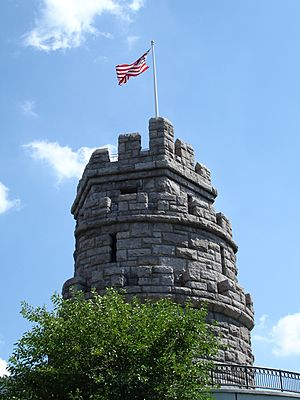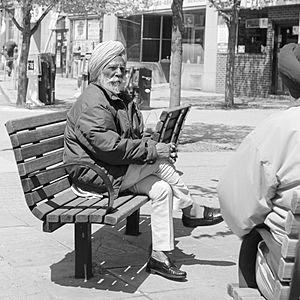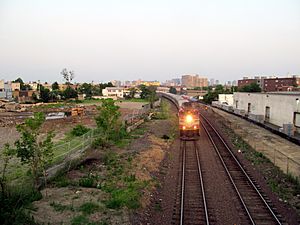Union Square (Somerville) facts for kids
Union Square is a lively neighborhood in Somerville, Massachusetts. It's a busy spot where Washington Street, Webster Avenue, and Somerville Avenue meet. The area got its name because it was a meeting place for soldiers during the American Civil War. These soldiers were part of the Union Army.
Today, Union Square is a busy center with lots of restaurants, shops, and places to hang out. It's the oldest and biggest business area in Somerville. You can find important community places here, like the Somerville Police station. It also hosts Somerville Community Access Television (SCATV) and Boston Free Radio.
Contents
History of Union Square
Early Days as Sand Pit Square
Union Square was one of the first business areas in Somerville. This was back when Somerville was still part of Charlestown. Important trade routes passed through the Square. A tavern, which is like an old inn, was built there as early as 1770. The area was first called "Sand Pit Square." This was because its sandy fields had clay pits. These pits provided special sand used to make glass and bricks.
Revolutionary War and Prospect Hill
Union Square became very important during the American Revolution. A nearby place called Prospect Hill was key. It offered amazing views and control over Charlestown, Somerville, and Cambridge. This made it a very important spot for military plans. People even called it the "Citadel." A monument shaped like a castle was built in 1903. It remembers the forts that stood on the hill during the war. A tablet inside the monument honors soldiers from both the Revolution and the Civil War.
Somerville is one of the places that claims to have first raised the U.S. Flag. This flag was called the Grand Union Flag. It's a tradition that George Washington raised this flag on Prospect Hill on January 1, 1776. A plaque on the hill says this happened. However, some historians think the flag raised was actually a British Union Flag. At that time, the British were offering to surrender to the colonists. So, raising a flag similar to the British one might have been mistaken for a sign of surrender.
Growing Industries and New Names
In its early years, Somerville was mostly farmland. It supplied food to the growing city of Boston. For a while, the Union Square area was known as Milk Row. This was because of the many small farms around it.
Union Square became a major business hub in the early 1800s. This was thanks to its location at an important crossroads. When the Warren Bridge opened in 1828, traffic increased a lot. This traffic moved along Washington Street and Charlestown Lane (now Somerville Avenue). Trains also arrived when the Fitchburg Railroad opened in 1843. A train station, the Union Square railroad station, opened just west of Webster Street.
The Boynton Yards area was created in 1874. This swampy land was filled in with dirt from Prospect Hill. It became a place for meat packing and factories. There was a slaughterhouse, a brickyard, a glass shop, and other businesses later on.
After 1853, the square was called Liberty Pole Square. This honored a "liberty pole" put up by firefighters who were against slavery. In 1861, it was renamed Union Square again. This name showed support for keeping the country together during the American Civil War. It also honored the square's role in the Revolutionary War.
In 1917, the first Marshmallow Fluff was sold in stores. It was made right here in Union Square! To celebrate this, Somerville has held an annual Fluff Festival in Union Square since 2006.
The Union Square train station closed in 1938. This happened because streetcars and buses offered new ways to travel. By then, Union Square had good public transportation.
Modern Changes and Community Life
Like many areas, Union Square faced economic challenges in the 1900s. Wealthy people moved to suburbs, and factories left the area. In the 1980s, the city started planning to improve Boynton Yards. New roads were built to help trucks reach businesses. This led to new factories moving in. These included Taza Chocolate, several breweries, and other food companies.
Union Square became home to new groups of immigrants in the late 1900s. Many Brazilian, Punjabi, and Sikh residents moved here. Many stores in the area are now run by and serve these different groups.
Union Square is a meeting point for different parts of Somerville. It has seen many changes as new cafes, bars, and restaurants have opened since the 1990s. This has brought new growth to Somerville. A local group called Union Square Main Streets started a Saturday morning farmers' market in 2005. There's also a community garden nearby with concerts and art events.
Getting Around Union Square
Union Square is a small hub for MBTA bus service. Five different bus routes pass through the area:
- 85 goes from Spring Hill to Kendall/M.I.T. station.
- 86 travels from Sullivan station to Reservoir (Cleveland Circle).
- 87 connects Arlington Center or Clarendon Hill to Lechmere station.
- 91 runs from Sullivan Square station to Central Square.
- CT2 goes from Sullivan station to Ruggles station.
Green Line Extension Project
A new train station, the Union Square station, is being built. It's part of the Green Line Extension project. This station will be just south of the main square. In 2013, the state got money for the project. They signed a contract to open the Union Square station, along with new stations at East Somerville station and a moved Lechmere station, by 2017. In 2014, the Union Square station was expected to open in December 2017. However, as of April 2019, it was planned to open in late 2021.




